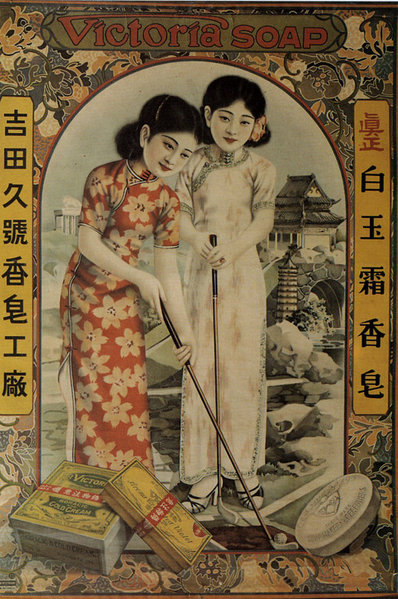| The above article is licensed under the GNU Free Documentation License. From Wikipedia, the free encyclopedia (https://en.wikipedia.org/wiki/cheongsam).Definition Modified by Apparel Search 1/6/06 |
|
|
The qipao (旗袍), qipaor (旗袍儿), or ch'i-p'ao, also known as the cheongsam or mandarin gown, is a body-hugging dress for women inChina originating from the Manchus, modernized and improved in Shanghai.
The English loanword cheongsam, which comes from Cantonese, is used for the garment when worn by either men or women. The word qipao refers only to a woman's clothes. Cheongsam were the formal dress for Chinese men before Western-style suits became common in China; they are not often worn today, except during traditional Chinese celebrations or as stylish party dresses.
History
When the Manchu began to rule China (Qing Dynasty), certain social strata emerged. Among the strata were the Banners (qi), mostly Manchu, who as a group were called Banner People (旗人 pinyin: qi ren). Manchu women typically wore a one-piece dress that came to be known as the 旗袍 (qipao or banner dress). The qipao fit loosely and hung straight down the body. The garment proved popular and survived the political turmoil of the 1911 Xinhai Revolution that toppled the Qing Dynasty. It has become, with few changes, the archetypal dress for Chinese women.
Its modern version was first developed in Shanghai around 1900. Slender and form fitting with a high cut, it contrasted sharply with the traditional qipao which was designed to conceal the figure and be worn regardless of age. In Shanghai it was first known as 長衫 (Mandarin: changshan, Cantonese: cheongsam, Shanghainese IPA ASCII: /zANsE/).
The cheongsam (the Cantonese term later popularized by Hong Kong) went well with the western overcoat and scarf, and portrayed a unique East Asian modernity. As Western fashions changed, the basic cheongsam design changed too, introducing high-necked sleeveless dresses, bell-like sleeves, and the black lace frothing at the hem of a ball gown. By the 1940s, cheongsam came in transparent black, beaded bodices, matching capes, and even velvet. Later, checked fabrics also became quite common.
The 1949 Communist Revolution ended the cheongsam and other fashions in Shanghai, but the Shanghainese emigrants and refugees brought the fashion to Hong Kong where it has remained popular. Recently there has been a revival of the Shanghainese cheongsam in Shanghai and elsewhere in Mainland China; the Shanghainese style functions now mostly as a stylish party dress (see also Mao suit).
It is also important to note that a black cheongsam was and sometimes still is the burial attire for Chinese men, along with a rounded black hat. However, one must not mistake the cheongsam as burial attire exclusively, as it was/is worn in pictures, weddings and other more formal historically Chinese events.
The Tibetans and Vietnamese have related versions of this dress as their national dress.
The cheongsam in films
- In older movies about Wong Fei Hung, the kung fu master was always portrayed as a well-dressed gentleman in cheongsam.
- As recently as the 1970s, Sun Ma-chai (新馬仔), a male celebrity in Hong Kong, always wore a cheongsam for public appearances.
- The movie In the Mood for Love by Wong Kar-wai of a Shanghainese community in Hong Kong is notable for its use of a variety of cheongsams, even taking the spotlight away from the star actors Maggie Cheung and Tony Leung.
- In the movie Kill Bill, the French-Japanese female character Sofie Fatale wore a typical male black cheongsam in the movie.
- In the movie The World of Suzie Wong, Nancy Kwan made the cheongsam fashionable in the west for a short period
- In the movie Spider-Man, the character Mary Jane Watson (played by Kirsten Dunst) wore a cheongsam in one scene.
- In the video game Street Fighter, Chun Li wears a modified qi pao.
- In the video game Dead or Alive, Lei Fang wears a qi pao.
 |
|
|
|
| Discussion boards are a great place to meet other members of the fashion industry, get advice, and share information. This forum was created to discuss the topic of this page. If you have questions, or information to improve this page, please join in the community discussion below. Please keep the communication on topic and for the purpose of education. |
|
|
